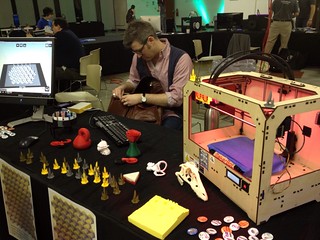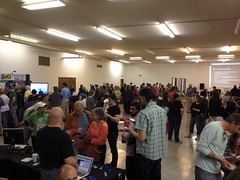Today is the scheduled Go Live date for the first implementation of the OCLC Web Scale Management services, and we are so close that we can almost touch it. We spent the day doing massive testing of the various pieces of WMS: Circulation, Acquisitions, Cataloging, and our WMS-driven Worldcat Local, with the OCLC team working with us to tackle anything that popped up. As you might expect, being the first to implement this radically new a system brings things to light that neither we nor OCLC entirely knew about or understood…the infrastructure for this is only now really being tested with live data from a working library. I know that a lot of eyes are on this to see how it works (or doesn’t work), so here’s a quick rundown of where we are today.
Circulation could, as far as the system is concerned, go live now…it’s a functional system at this point, with all of our policies in place and working for all of our patron types. However, we now have a backlog of circ data to catch up on (the delta between the last massive data load and now), and we’re proceeding with it, and with further data-verification testing at the same time.
Acquisitions/Cataloging is so, so close. We successfully received and cataloged books today from scratch for the very first time, and walked them all the way through the process of preparing them to circulate. As a part of this process we discovered that we are going to have to re-evaluate our workflows even more…even we, who have been preparing for this for 6 weeks now, didn’t really grok the degree to which this alters our traditional workflow. So over the next few days, we’re going to be taking a closer look at those, and see how we take advantage of the massively streamlined workflows that are possible with WMS. Acquisitions is still very much a module in progress…it’s much ahead of schedule as far as the initial install schedule goes, and I’m impressed with how far it’s gotten in almost a ridiculously short timeframe.
The last piece of the puzzle is Worldcat Local, which is about 95% of the way there for our needs. The one major display issue cropped up last week as we started to see our serials holdings in Local, and that display issue is already scheduled as an out-of-cycle fix. We’ve seen the fixed display, and it works really well.
I can’t really explain how hard many people have worked to get us to this point. Andrea Schurr, our Web Technologies and ILS Librarian has worked multiple 80 hour weeks to get all our data out of our current system and into WMS. The entire staff at Lupton Library have laid other needs aside to help out with every little piece of this project, completing things in weeks that were timelined for months of work yet. And the team at OCLC has just kicked ass responding to questions, pushing for updates, and generally being amazing in helping us understand how this beautiful beast is constructed so that we can get the most out of it.
So with all that said, it comes down to: did we make our implementation date? Are we “live” with WMS? At this point, for my purposes, we are. We have about 98% of our data in the system, and the few straggling records are ones that require some serious cleanup…which we’re doing, and those will be done in the next couple of weeks. We are are working towards catching up our circulation activity of the last 2-3 weeks, which will take a few days. As well, we are going to take a few more days to examine our acquisitions and cataloging practices in order to make sure that we’re using the system and our staff as efficiently as possible, and then begin the process of catching those data bits up…if you aren’t processing as you go, it’s amazing how quickly things fall out of sync. And our patrons are already using Worldcat Local, driven by WMS data, for discovery and resource location.
Are we as live as I’d hoped? Honestly, no, we’re not. But as my Dean keeps reminding me: it’s not about us, it’s about the patrons. We have to get just a bit more testing, more data verification, and more workflow examination on our end in order to make sure that what we’re delivering to our patrons is the best possible experience we can for resource discovery at UTC.
Here’s my takeaway from this whole process up to this point: we now have the first working system of this kind in any library in the world. We moved from our previous ILS to this completely new model and set of data structures in just 6 weeks, or roughly 1/6th the time of the average ILS migration. We are working very hard, still, to make this as good an experience as we can for our students, faculty, and staff. Who can complain if we take a couple of extra days to triple check a few things? 🙂



